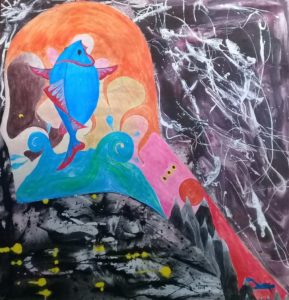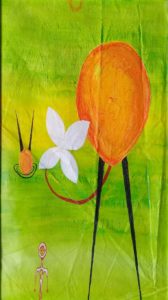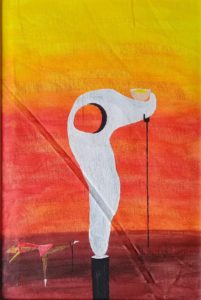
THE WONDERFUL WORLD OF DANIEL LEMMER
I had no idea who Daniel Lemmer was until six months ago. My own fault of course, but there may be a (pathetic) excuse for my lack of knowledge. He works outside Paramaribo, in the back of the place where his father builds, repairs and stores his musical instruments. Lemmer exhibits sporadically and certainly has no regular gallery let alone participates in any exhibitions abroad. His Google ranking has not yet risen above “low”. A couple of his paintings can be found on the Saatchi Art site. Outside the art circuit he has built up a clientele who either buy his work or are at least interested in it.
He seems to be happy with the situation.


Which makes the fact that he is now showing a number of his pieces at Sukru Oso actually both remarkable and at the same time fortunate, since his work is in every way worthy of reaching a larger audience.
He does not want to talk about the meaning of his work. He says he prefers to leave interpretations to the viewer.
One is struck first by the absence of reality, unusual in a country where the depiction of reality still reigns supreme in art. Very occasionally recognizably human figures are the subject, for example in a restrained work where a woman has her back turned to the viewer, in most works people, plants and animals are reduced to shapes which form part of a larger, literally fantastic whole, of a refined, fascinating composition. These shapes are often round or rounded off. It is not unusual for there to be holes in them. Sometimes the artist hangs something on them, giving the shape the function of an actual object – a swing for example – without looking like one. Sometimes they stand on legs as if they could walk. Sometimes a flower hangs on or underneath them. Sometimes shapes look like sorts of tentacled fish.


In many paintings Daniel Lemmer chooses a simple, almost monotone background. This brings out the best of the other colors, the combinations of colors, the gradations of colors, the interplay between colors. The static background also seems to accentuate the liveliness of the shapes.
What is particularly noticeable is that Lemmer’s works can easily be placed in an international context. It is as if Dali, Miró, but also Rodchenko and Lissitzky have crossed over to Suriname. Surrealism and Constructivism have miraculously met up inside the imaginary world of a born and bred Surinamese man. Fraternization such as this seldom occurs in art in Suriname. Remy Jungerman’s move to Modernism from for example De Stijl, could in his case be seen as comparable.


This exhibition also reveals that Lemmer is not averse to experimentation. There are some works among them that lack any color and in which Jackson Pollock watched over his shoulder. In others a small, recognizable color element, a greenish-yellow butterfly for instance, undermines (or mocks) the Abstract Expressionism of the American fellow artist. While in most works the shapes and colors are defined, in others drips and transparent ‘smudges’ are functional elements of a vibrant whole.


I recently saw a number of Daniel Lemmer’s YouTube videos. Surprising, I didn’t know he made them. Like scenes from an absurdist Samuel Beckett play. Beautifully stark, minimalistically filmed so that the mysterious drama of the deliberately unrecognizable main character can demand all the attention. Although these are short films, obeying the ‘rules’ of the medium, in my view they can be seen as an extension of his other work. They are just as surrealist, just as refined and effectively designed. The presence of the artist probably makes them more personal, but not any easier to understand. They are just as suggestive and enigmatic as Beckett’s famous play Waiting for Godot, which leaves you with a gnawing what-is-actually-happening-here-question.
